Bosch GWS 21-180 H, GWS 21-230 H User Manual
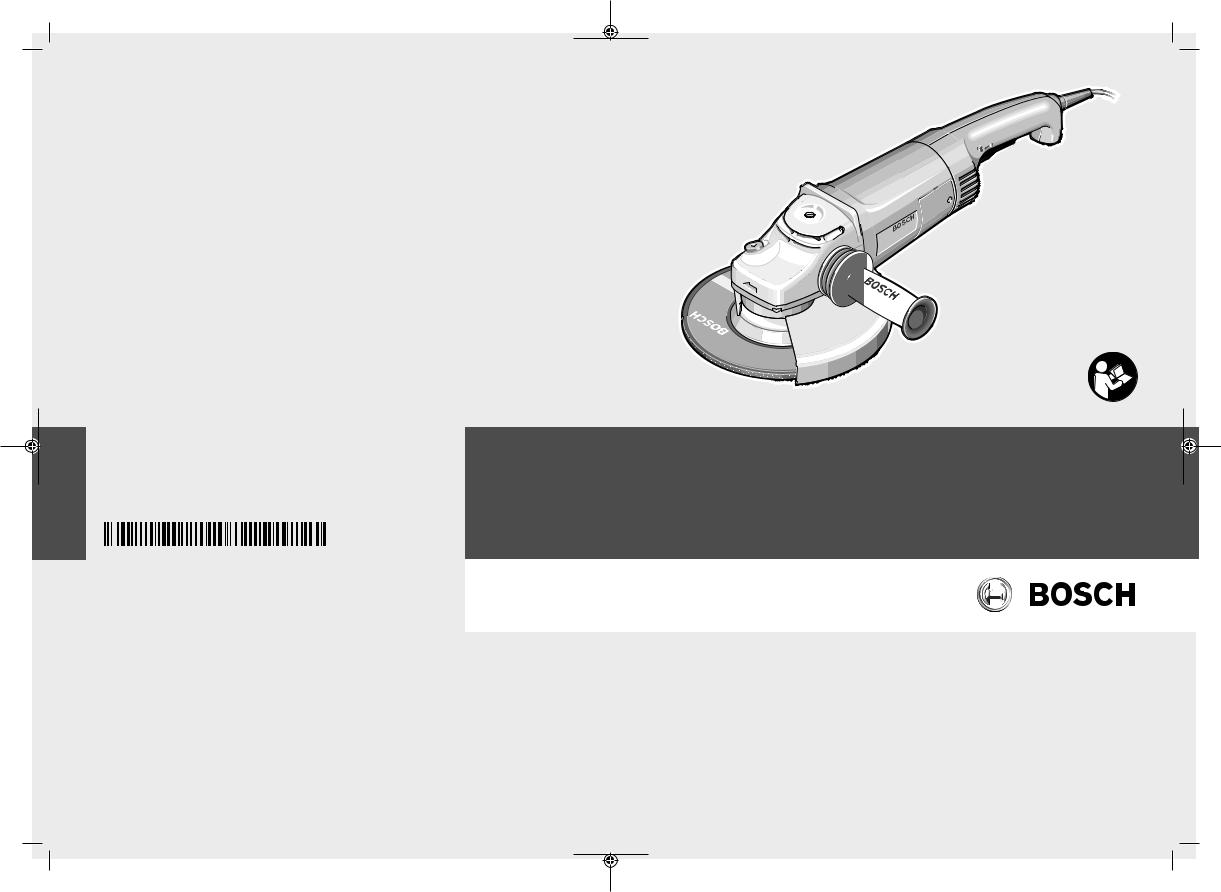
Robert Bosch Power Tools GmbH
70538 Stuttgart
GERMANY
www.bosch-pt.com
1 609 92A 438 (2018.11) O / 43
1 609 92A 438
GWS Professional
21-180 H | 21-230 H
en Original instructions
fr Notice originale
ar يلصلأا ليغشتلا ليلد fa یلصا یامنهار هچرتفد

2 |
English ................................................... |
Page |
6 |
Français .................................................. |
Page |
14 |
يبرع .................................................. |
ةحفصلا |
23 |
یسرافآ.................................................. |
هحفص |
32 |
1 609 92A 438 | (26.11.2018) |
|
|
|
Bosch Power Tools |
|
|
|
|
|
|
|
|
|
|
|
|
|
|
|
|
|
|
|

| 3
Bosch Power Tools |
|
|
|
1 609 92A 438 | (26.11.2018) |
|
|
|
|
|
|
|
|
|
|
|
|
|
|
|
|
|
|
|
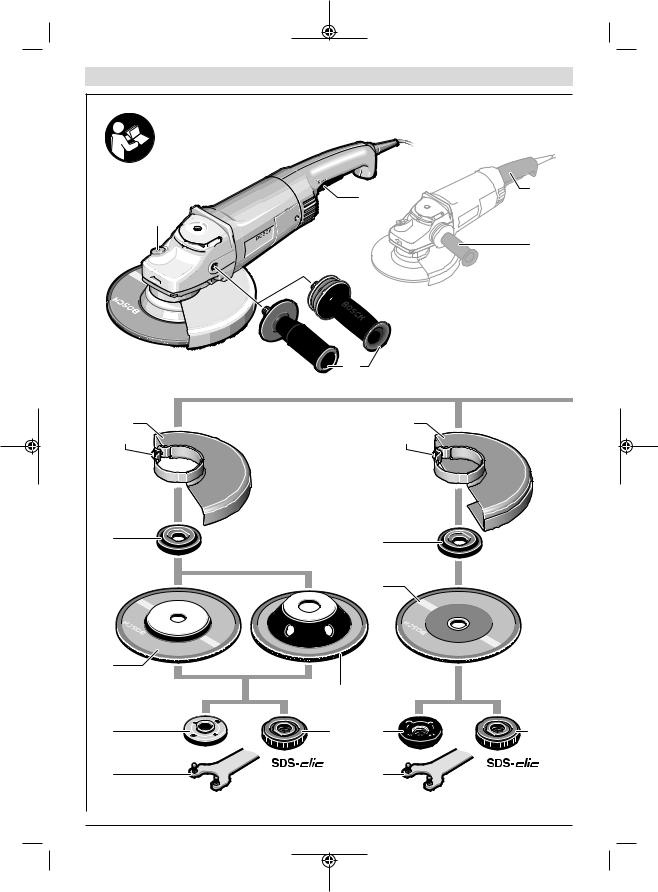
4 | |
|
|
|
|
|
(2) |
(23) |
|
|
|
|
(1) |
|
|
|
|
|
|
(3) |
|
(3) |
|
|
(5) |
|
|
(13) |
(6) |
|
|
(6) |
(7) |
|
(7) |
|
|
|
|
|
|
|
(14) |
|
(8) |
|
|
|
|
(12) |
|
|
(9) |
(11) |
(9) |
(11) |
(10) |
|
(10) |
|
1 609 92A 438 | (26.11.2018) |
|
|
Bosch Power Tools |
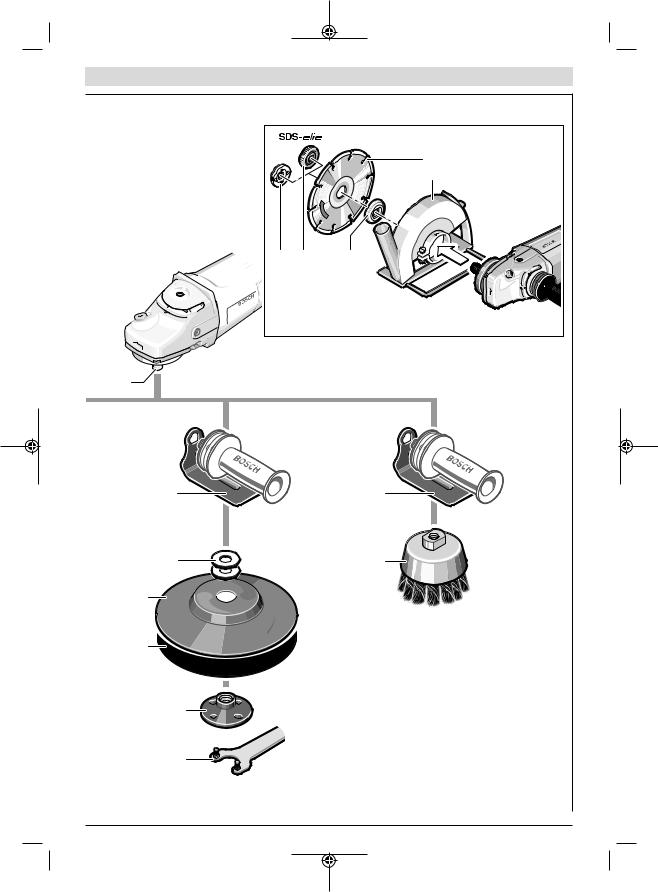
|
|
| 5 |
|
|
(22) |
|
|
(21) |
(9) |
(11) |
(7) |
(4) |
|
|
(15) |
|
(15) |
(16) |
|
(20) |
(17) |
|
|
(18) |
|
|
(19) |
|
|
(10) |
|
GWS 21-180 H |
|
|
GWS 21-230 H |
Bosch Power Tools |
|
1 609 92A 438 | (26.11.2018) |
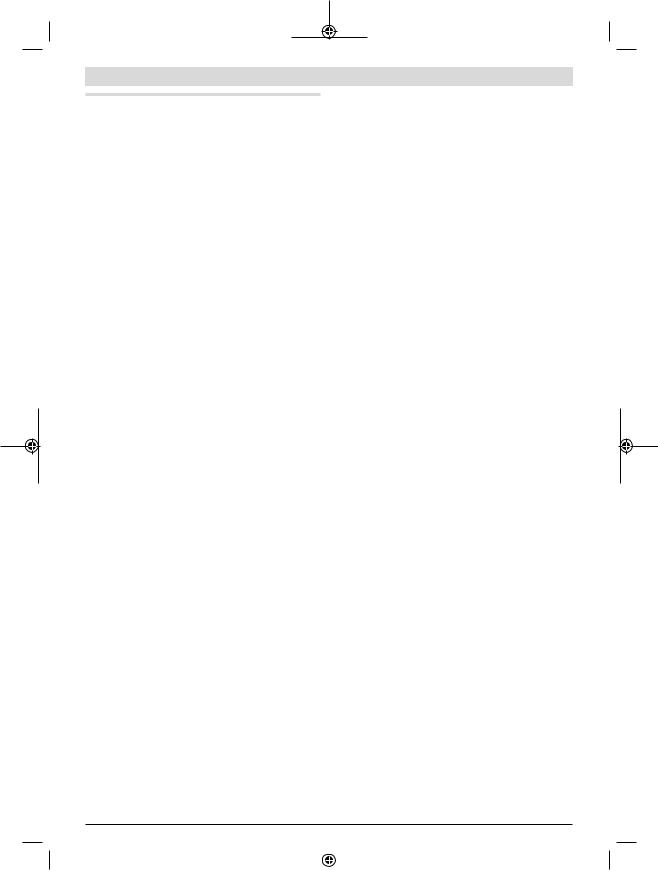
6 | English
English
Safety instructions
General Power Tool Safety Warnings
 WARNING Read all safety warnings and all instructions. Failure to follow the
WARNING Read all safety warnings and all instructions. Failure to follow the
warnings and instructions may result in electric shock, fire
and/or serious injury.
Save all warnings and instructions for future reference.
The term "power tool" in the warnings refers to your mainsoperated (corded) power tool or battery-operated (cordless) power tool.
Work area safety
uKeep work area clean and well lit. Cluttered or dark areas invite accidents.
uDo not operate power tools in explosive atmospheres, such as in the presence of flammable liquids, gases or dust. Power tools create sparks which may ignite the dust or fumes.
uKeep children and bystanders away while operating a power tool. Distractions can cause you to lose control.
Electrical safety
uPower tool plugs must match the outlet. Never modify the plug in any way. Do not use any adapter plugs with earthed (grounded) power tools. Unmodified plugs and matching outlets will reduce risk of electric shock.
uAvoid body contact with earthed or grounded surfaces, such as pipes, radiators, ranges and refrigerators. There is an increased risk of electric shock if your body is earthed or grounded.
uDo not expose power tools to rain or wet conditions.
Water entering a power tool will increase the risk of electric shock.
uDo not abuse the cord. Never use the cord for carrying, pulling or unplugging the power tool. Keep cord away from heat, oil, sharp edges or moving parts.
Damaged or entangled cords increase the risk of electric shock.
uWhen operating a power tool outdoors, use an extension cord suitable for outdoor use. Use of a cord suitable for outdoor use reduces the risk of electric shock..
uIf operating a power tool in a damp location is unavoidable, use a residual current device (RCD) protected supply. Use of an RCD reduces the risk of electric shock.
Personal safety
uStay alert, watch what you are doing and use common sense when operating a power tool. Do not use a power tool while you are tired or under the influence of drugs, alcohol or medication. A moment of inattention while operating power tools may result in serious personal injury.
uUse personal protective equipment. Always wear eye protection. Protective equipment such as dust mask, non-skid safety shoes, hard hat, or hearing protection used for appropriate conditions will reduce personal injuries.
uPrevent unintentional starting. Ensure the switch is in the off-position before connecting to power source and/or battery pack, picking up or carrying the tool.
Carrying power tools with your finger on the switch or energising power tools that have the switch on invites accidents.
uRemove any adjusting key or wrench before turning the power tool on. A wrench or a key left attached to a rotating part of the power tool may result in personal injury.
uDo not overreach. Keep proper footing and balance at all times. This enables better control of the power tool in unexpected situations.
uDress properly. Do not wear loose clothing or jewellery. Keep your hair, clothing and gloves away from moving parts. Loose clothes, jewellery or long hair can be caught in moving parts.
uIf devices are provided for the connection of dust extraction and collection facilities, ensure these are connected and properly used. Use of dust collection can reduce dust-related hazards.
Power tool use and care
uDo not force the power tool. Use the correct power tool for your application. The correct power tool will do the job better and safer at the rate for which it was designed.
uDo not use the power tool if the switch does not turn it on and off. Any power tool that cannot be controlled with the switch is dangerous and must be repaired.
uDisconnect the plug from the power source and/or the battery pack from the power tool before making any adjustments, changing accessories, or storing power tools. Such preventive safety measures reduce the risk of starting the power tool accidentally.
uStore idle power tools out of the reach of children and do not allow persons unfamiliar with the power tool or these instructions to operate the power tool. Power tools are dangerous in the hands of untrained users.
uMaintain power tools. Check for misalignment or binding of moving parts, breakage of parts and any other condition that may affect the power tool’s operation. If damaged, have the power tool repaired before use.
Many accidents are caused by poorly maintained power tools.
uKeep cutting tools sharp and clean. Properly maintained cutting tools with sharp cutting edges are less likely to bind and are easier to control.
uUse the power tool, accessories and tool bits etc. in accordance with these instructions, taking into account the working conditions and the work to be per-
1 609 92A 438 | (26.11.2018) |
|
|
|
Bosch Power Tools |
|
|
|
|
|
|
|
|
|
|
|
|
|
|
|
|
|
|
|

formed. Use of the power tool for operations different
from those intended could result in a hazardous situation.
Service
uHave your power tool serviced by a qualified repair person using only identical replacement parts. This will ensure that the safety of the power tool is maintained.
Safety information for the angle grinder
Safety Warnings common for Grinding, Sanding, Wire Brushing or Abrasive Cutting Off operations
uThis power tool is intended to function as a grinder, sander, wire brush or cut-off tool. Read all safety warnings, instructions, illustrations and specifications provided with this power tool. Failure to follow all instructions listed below may result in electric shock, fire and/or serious injury.
uOperations such as polishing are not recommended to be performed with this power tool. Operations for which the power tool was not designed may create a hazard and cause personal injury.
uDo not use accessories which are not specifically designed and recommended by the tool manufacturer.
Just because the accessory can be attached to your power tool, it does not assure safe operation.
uThe rated speed of the accessory must be at least equal to the maximum speed marked on the power tool. Accessories running faster than their rated speed can break and fly apart.
uThe outside diameter and the thickness of your accessory must be within the capacity rating of your power tool. Incorrectly sized accessories cannot be adequately guarded or controlled.
uThreaded mounting of accessories must match the grinder spindle thread. For accessories mounted by flanges, the arbour hole of the accessory must fit the locating diameter of the flange. Accessories that do not match the mounting hardware of the power tool will run out of balance, vibrate excessively and may cause loss of control.
uDo not use a damaged accessory. Before each use inspect the accessory such as abrasive wheels for chips and cracks, backing pad for cracks, tear or excess wear, wire brush for loose or cracked wires. If power tool or accessory is dropped, inspect for damage or install an undamaged accessory. After inspecting and installing an accessory, position yourself and bystanders away from the plane of the rotating accessory and run the power tool at maximum no load speed for one minute. Damaged accessories will normally break apart during this test time.
uWear personal protective equipment. Depending on application, use face shield, safety goggles or safety glasses. As appropriate, wear dust mask, hearing protectors, gloves and workshop apron capable of stopping small abrasive or workpiece fragments. The eye protection must be capable of stopping flying debris gen-
English | 7
erated by various operations . The dust mask or respirator must be capable of filtrating particles generated by your operation. Prolonged exposure to high intensity noise may cause hearing loss.
uKeep bystanders a safe distance away from work area. Anyone entering the work area must wear personal protective equipment. Fragments of workpiece or of a broken accessory may fly away and cause injury beyond immediate area of operation.
uHold the power tool by insulated gripping surfaces only, when performing an operation where the cutting accessory may contact hidden wiring or its own cord.
Cutting accessory contacting a "live" wire may make exposed metal parts of the power tool "live" and could give the operator an electric shock.
uPosition the cord clear of the spinning accessory. If you lose control, the cord may be cut or snagged and your hand or arm may be pulled into the spinning accessory.
uNever lay the power tool down until the accessory has come to a complete stop. The spinning accessory may grab the surface and pull the power tool out of your control.
uDo not run the power tool while carrying it at your side. Accidental contact with the spinning accessory could snag your clothing, pulling the accessory into your body.
uRegularly clean the power tool’s air vents. The motor’s fan will draw the dust inside the housing and excessive accumulation of powdered metal may cause electrical hazards.
uDo not operate the power tool near flammable materials. Sparks could ignite these materials.
uDo not use accessories that require liquid coolants.
Using water or other liquid coolants may result in electrocution or shock.
Kickback and Related Warnings
Kickback is a sudden reaction to a pinched or snagged rotating wheel, backing pad, brush or any other accessory. Pinching or snagging causes rapid stalling of the rotating accessory which in turn causes the uncontrolled power tool to be forced in the direction opposite of the accessory’s rotation at the point of the binding.
For example, if an abrasive wheel is snagged or pinched by the workpiece, the edge of the wheel that is entering into the pinch point can dig into the surface of the material causing the wheel to climb out or kick out. The wheel may either jump toward or away from the operator, depending on direction of the wheel’s movement at the point of pinching. Abrasive wheels may also break under these conditions.
Kickback is the result of power tool misuse and/or incorrect operating procedures or conditions and can be avoided by taking proper precautions as given below.
uMaintain a firm grip on the power tool and position your body and arm to allow you to resist kickback forces. Always use auxiliary handle, if provided, for maximum control over kickback or torque reaction
Bosch Power Tools |
|
|
|
1 609 92A 438 | (26.11.2018) |
|
|
|
|
|
|
|
|
|
|
|
|
|
|
|
|
|
|
|
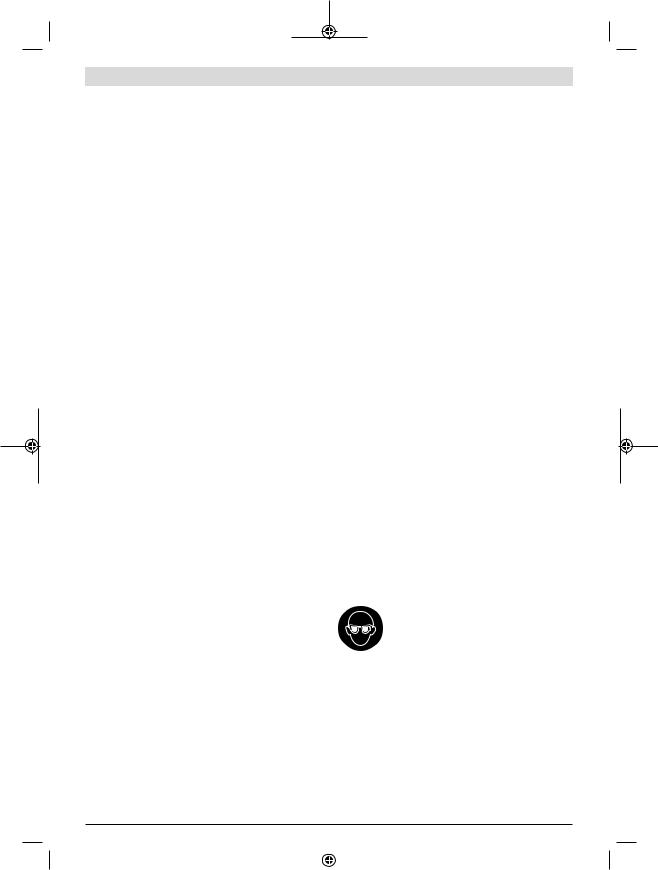
8 | English
during start-up. The operator can control torque reac-
tions or kickback forces, if proper precautions are taken.
uNever place your hand near the rotating accessory.
Accessory may kickback over your hand.
uDo not position your body in the area where power tool will move if kickback occurs. Kickback will propel the tool in direction opposite to the wheel’s movement at the point of snagging.
uUse special care when working corners, sharp edges etc. Avoid bouncing and snagging the accessory.
Corners, sharp edges or bouncing have a tendency to snag the rotating accessory and cause loss of control or kickback.
uDo not attach a saw chain woodcarving blade or toothed saw blade. Such blades create frequent kickback and loss of control.
Safety Warnings specific for Grinding and Abrasive Cutting-Off operations
uUse only wheel types that are recommended for your power tool and the specific guard designed for the selected wheel. Wheels for which the power tool was not designed cannot be adequately guarded and are unsafe.
uThe grinding surface of centre depressed wheels must be mounted below the plane of the guard lip. An improperly mounted wheel that projects through the plane of the guard lip cannot be adequately protected.
uThe guard must be securely attached to the power tool and positioned for maximum safety, so the least amount of wheel is exposed towards the operator.
The guard helps to protect operator from broken wheel fragments, accidental contact with wheel and sparks that could ignite clothing.
uWheels must be used only for recommended applications. For example: do not grind with the side of cutoff wheel. Abrasive cut-off wheels are intended for peripheral grinding, side forces applied to these wheels may cause them to shatter.
uAlways use undamaged wheel flanges that are of correct size and shape for your selected wheel. Proper wheel flanges support the wheel thus reducing the possibility of wheel breakage. Flanges for cut-off wheels may be different from grinding wheel flanges.
uDo not use worn down wheels from larger power tools. Wheel intended for larger power tool is not suitable for the higher speed of a smaller tool and may burst.
Additional Safety Warnings specific for Abrasive Cutting Off operations
uDo not “jam” the cut-off wheel or apply excessive pressure. Do not attempt to make an excessive depth of cut. Overstressing the wheel increases the loading and susceptibility to twisting or binding of the wheel in the cut and the possibility of kickback or wheel breakage.
uDo not position your body in line with and behind the rotating wheel. When the wheel, at the point of operation, is moving away from your body, the possible kick-
back may propel the spinning wheel and the power tool
directly at you.
uWhen wheel is binding or when interrupting a cut for any reason, switch off the power tool and hold the power tool motionless until the wheel comes to a complete stop. Never attempt to remove the cut-off wheel from the cut while the wheel is in motion otherwise kickback may occur. Investigate and take corrective action to eliminate the cause of wheel binding.
uDo not restart the cutting operation in the workpiece. Let the wheel reach full speed and carefully re-enter the cut. The wheel may bind, walk up or kickback if the power tool is restarted in the workpiece.
uSupport panels or any oversized workpiece to minimize the risk of wheel pinching and kickback. Large workpieces tend to sag under their own weight. Supports must be placed under the workpiece near the line of cut and near the edge of the workpiece on both sides of the wheel.
uUse extra caution when making a “pocket cut” into existing walls or other blind areas. The protruding wheel may cut gas or water pipes, electrical wiring or objects that can cause kickback.
Safety Warnings specific for Sanding operations
uDo not use excessively oversized sanding disc paper. Follow manufacturers recommendations, when selecting sanding paper. Larger sanding paper extending beyond the sanding pad presents a laceration hazard and may cause snagging, tearing of the disc, or kickback.
Safety Warnings specific for Wire Brushing operations
uBe aware that wire bristles are thrown by the brush even during ordinary operation. Do not overstress the wires by applying excessive load to the brush The wire bristles can easily penetrate light clothing and/or skin.
uIf the use of a guard is recommended for wire brushing, do not allow any interference of the wire wheel or brush with the guard. Wire wheel or brush may expand in diameter due to work load and centrifugal forces.
Additional safety information
Wear safety goggles.
uUse suitable detectors to determine if utility lines are hidden in the work area or call the local utility company for assistance. Contact with electric lines can lead to fire and electric shock. Damaging a gas line can lead to explosion. Penetrating a water line causes property damage or may cause an electric shock.
uDo not touch grinding and cutting discs until they have cooled down. The discs can become very hot while working.
uRelease the On/Off switch and set it to the off position when the power supply is interrupted, e. g., in case of
1 609 92A 438 | (26.11.2018) |
|
|
|
Bosch Power Tools |
|
|
|
|
|
|
|
|
|
|
|
|
|
|
|
|
|
|
|
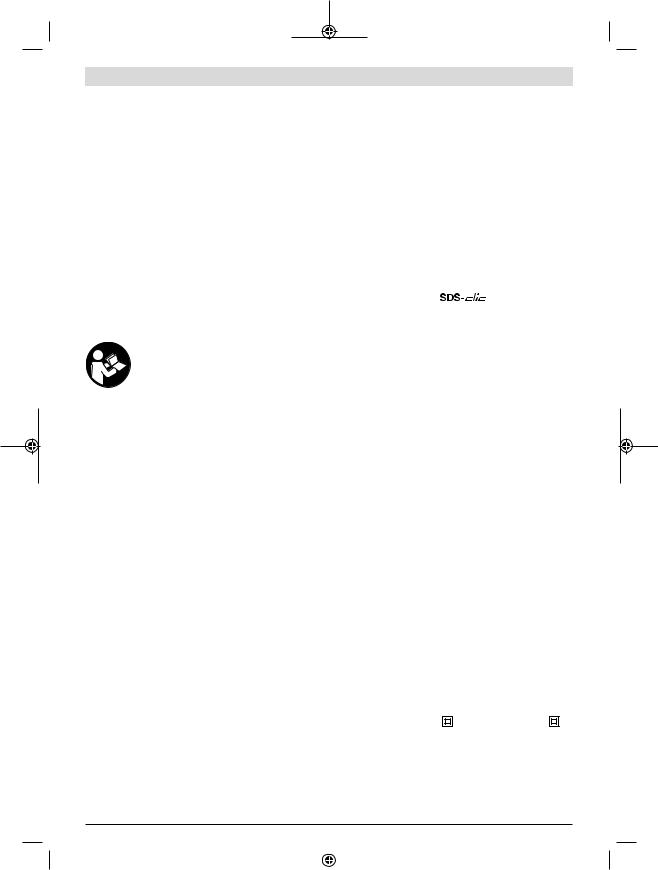
a power failure or when the mains plug is pulled. This
prevents uncontrolled restarting.
Products sold in GB only:
Your product is fitted with an BS 1363/A approved electric plug with internal fuse (ASTA approved to BS 1362).
If the plug is not suitable for your socket outlets, it should be cut off and an appropriate plug fitted in its place by an authorised customer service agent. The replacement plug should have the same fuse rating as the original plug.
The severed plug must be disposed of to avoid a possible shock hazard and should never be inserted into a mains socket elsewhere.
uSecure the workpiece. A workpiece clamped with clamping devices or in a vice is held more secure than by hand.
Product Description and
Specifications
Read all the safety and general instructions.
Failure to observe the safety and general instructions may result in electric shock, fire and/or serious injury.
Please observe the illustrations at the beginning of this operating manual.
Intended use
The power tool is intended for cutting, roughing and brushing metal and stone materials without the use of water.
A special protective guard for cutting must be used when cutting bonded abrasives.
Sufficient dust extraction must be provided when cutting stone.
With approved abrasive tools, the power tool can be used for sanding with sanding discs.
English | 9
Product Features
The numbering of the product features refers to the diagram of the power tool on the graphics page.
(1)Spindle lock button
(2)On/off switch
(3)Auxiliary handle (insulated gripping surface)
(4)Grinding spindle
(5)Protective guard for grinding
(6)Locking screw for protective guard
(7)Mounting flange with O ring
(8)Grinding discA)
(9)Clamping nut
(10)Two-pin spanner for clamping nutA)
A)
(11) Quick-clamping nut
(12) Carbide grinding headA)
(13) Protective guard for cuttingA)
(14) Cutting discA)
(15) Hand guardA)
(16) Spacer discsA)
(17) Rubber sanding padA)
(18) Abrasive discA)
(19) Round nutA)
(20) Cup brushA)
(21) Extraction guard for cutting with a guide blockA)
(22) Diamond cutting discA)
(23) Handle (insulated gripping surface)
A)Accessories shown or described are not included with the product as standard. You can find the complete selection of accessories in our accessories range.
Technical Data
Angle grinder |
|
GWS 21-180 H |
GWS 21-230 H |
Article number |
|
0 601 851 0.. |
0 601 852 0.. |
Rated power input |
W |
2100 |
2100 |
Power output |
W |
1350 |
1350 |
Rated speed |
min-1 |
8500 |
6500 |
Max. grinding disc diameter |
mm |
180 |
230 |
Grinding spindle thread |
|
M 14 |
M 14 |
Max. thread length of grinding spindle |
mm |
25 |
25 |
Weight according to EPTA-Procedure 01:2014 |
kg |
5.0 |
5.2 |
Protection class |
|
/ II |
/ II |
The specifications apply to a rated voltage [U] of 230 V. These specifications may vary at different voltages and in country-specific models.
When switching on power tools with starting current limitation, the voltage drops briefly. Interference with other equipment may occur in the event of unfavourable conditions in the electricity supply. Malfunctions are not expected if the impedances in the electricity supply are below 0.25 ohms.
Bosch Power Tools |
|
|
|
1 609 92A 438 | (26.11.2018) |
|
|
|
|
|
|
|
|
|
|
|
|
|
|
|
|
|
|
|
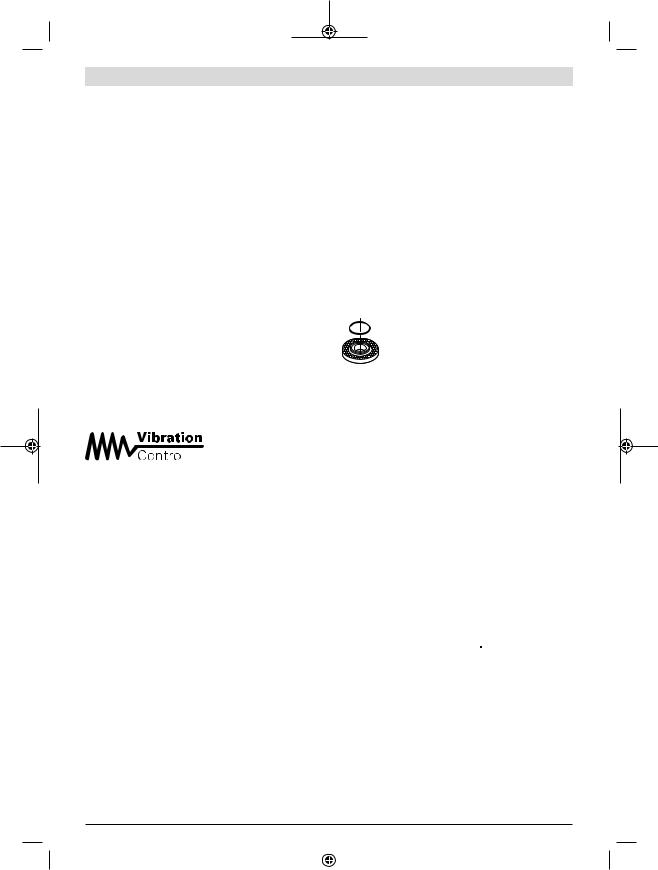
10 | English
Fitting
Fitting protective equipment
uPull the plug out of the socket before carrying out any work on the power tool.
Note: If the grinding disc breaks during operation or the holding fixtures on the protective guard/power tool become damaged, the power tool must be sent to the after-sales service immediately; see the "After-sales service and advice on using products" section for addresses.
Protective guard for grinding
Place the protective guard (5) on the spindle collar. Adjust the position of the protective guard (5) to the requirements of the operation and lock the protective guard (5) with the locking screw (6).
uAdjust the protective guard (5) such that sparking in the direction of the operator is prevented.
Protective guard for cutting
uAlways use the protective guard for cutting (13) when cutting bonded abrasives.
uProvide sufficient dust extraction when cutting stone.
The protective guard for cutting (13) is fitted in the same way as the protective guard for grinding (5).
Low-vibration auxiliary handle
Screw the auxiliary handle
(3) on the right or left of the machine head depending on the working method.
The low-vibration auxiliary handle reduces vibration, enabling the tool to be used safely and more comfortably.
uDo not operate your power tool without the side handle (3).
uDo not make any alterations of any kind to the auxiliary handle.
Do not continue to use a damaged auxiliary handle.
Hand guard
uAlways fit the hand guard (15) when working with the rubber sanding pad (17) or with the cup brush/disc brush/flap disc.
Attach the hand guard (15) to the side handle (3).
Fitting the abrasive tools
uPull the plug out of the socket before carrying out any work on the power tool.
uDo not touch grinding and cutting discs until they have cooled down. The discs can become very hot while working.
Clean the grinding spindle (4) and all the parts to be fitted. Lock the grinding spindle with the spindle lock button (1) before clamping and releasing the abrasive tools.
uDo not press the spindle lock button while the grinding spindle is moving. The power tool may become damaged if you do this.
Grinding/cutting disc
Pay attention to the dimensions of the abrasive tools. The diameter of the hole must match that of the hub flange. Do not use an adapter or reducer.
When using diamond cutting discs, make sure that the arrow indicating the direction of rotation on the diamond cutting disc matches the direction of rotation of the power tool (see the direction of rotation arrow on the machine head).
See the graphics page for fitting instructions.
To fasten the grinding/cutting disc, screw on the clamping nut (9) and tighten with the two-pin spanner; see the "Quickclamping nut" section.
uAfter fitting the abrasive tool, check that the abrasive tool is fitted correctly and can turn freely before switching on the power tool. Make sure that the abrasive tool does not brush against the protective guard or other parts.
A plastic part (O-ring) is fitted around the centring collar in the hub flange (7). If the O-ring is missing or damaged, the hub flange (7) must be replaced before operation can resume.
Flap disc
uAlways fit the hand guard (15) when working with the flap disc.
Rubber sanding pad
uAlways fit the hand guard (15) when working with the rubber sanding pad (17).
See the graphics page for fitting instructions.
Before fitting the rubber sanding pad (17), place the two spacer discs (16) on the grinding spindle (4).
Screw on the round nut (19) and tighten with the two-pin spanner.
Cup brush/disc brush
uAlways fit the hand guard (15) when working with the cup brush or disc brush.
See the graphics page for fitting instructions.
The cup brush/disc brush must be screwed onto the grinding spindle until it rests firmly against the grinding spindle flange at the end of the grinding spindle thread. Tighten the cup brush/disc brush with an open-ended spanner.
Quick-clamping nut 



To change the abrasive tool easily without having to use any additional tools, you can use the quick-clamping nut (11) instead of the clamping nut (9).
uThe quick-clamping nut (11) may be used only for grinding or cutting discs.
Only use quick-clamping nuts (11) that are in good work-
ing order and not damaged.
When screwing on, make sure that the printed side of the quick-clamping nut (11) is not facing the grinding disc; the arrow must be pointing towards the index mark (24).
1 609 92A 438 | (26.11.2018) |
|
|
|
Bosch Power Tools |
|
|
|
|
|
|
|
|
|
|
|
|
|
|
|
|
|
|
|

(24) |
tools |
Press the spindle lock button (1) to lock the grinding spindle. To tighten the quick-clamping nut, turn the grinding disc firmly clockwise.
If the quick-clamping nut has been attached correctly and is not damaged, you can loosen it by hand by turning the knurled ring anticlockwise. If the quickclamping nut is stuck, do not attempt to loosen it with pliers – always use the two-pin spanner. Position the two pin spanner as shown in the figure.
Approved abrasive
You can use all the abrasive tools mentioned in these operating instructions.
The permissible speed [rpm] or the circumferential speed [m/s] of the abrasive tools used must at least match the values given in the table.
It is therefore important to observe the permissible rotational/circumferential speed on the label of the abrasive
tool.
|
|
max. [mm] |
[mm] |
|
|
|
|
|
D |
b |
d |
[min-1] [m/s] |
|
|
|
180 |
8 |
22.2 |
8500 |
80 |
|
|
230 |
8 |
22.2 |
6500 |
80 |
D |
|
180 |
– |
– |
8500 |
80 |
|
|
|||||
|
|
230 |
– |
– |
6500 |
80 |
|
D |
100 |
30 |
M 14 |
8500 |
45 |
|
|
|||||
B
D
Rotating the machine head
uPull the plug out of the socket before carrying out any work on the power tool.
English | 11
The machine head can be ro-
tated in 90° increments. This
enables the on/off switch to
be brought into a more con-
venient position for particular
working situations, such as
cutting operations using the
extraction guard for cutting with a guide block (21) or for left-handed persons.
Completely unscrew the four screws. Rotate the machine head carefully, without removing it from the housing, into the new position. Screw in and retighten the four screws.
Dust/chip extraction
The dust from materials such as lead paint, some types of wood, minerals and metal can be harmful to human health. Touching or breathing in this dust can trigger allergic reactions and/or cause respiratory illnesses in the user or in people in the near vicinity.
Certain dusts, such as oak or beech dust, are classified as carcinogenic, especially in conjunction with wood treatment additives (chromate, wood preservative). Materials containing asbestos may only be machined by specialists.
–Use a dust extraction system that is suitable for the material wherever possible.
–Provide good ventilation at the workplace.
–It is advisable to wear a P2 filter class breathing mask. The regulations on the material being machined that apply in the country of use must be observed.
uAvoid dust accumulation at the workplace. Dust can easily ignite.
Operation
Start-up
uPay attention to the mains voltage. The voltage of the power source must match the voltage specified on the rating plate of the power tool. Power tools marked with 230 V can also be operated with 220 V.
uHold the tool by the insulated gripping surfaces and auxiliary handle only. The application tool could come into contact with hidden wiring or its own cord. Contact with live wires may make metal parts of the tool live, posing a risk of electric shock.
When operating the power tool using a mobile generator that does not have sufficient reserve capacity or an adequate voltage control system with inrush current boost converter, loss of performance or atypical behaviour may occur upon switch-on.
Please check the suitability of the power generator you are using, particularly with regard to the mains voltage and frequency.
uProducts that are only sold in AUS and NZ: Use a residual current device (RCD) with a nominal residual current of 30 mA or less.
Bosch Power Tools |
|
|
|
1 609 92A 438 | (26.11.2018) |
|
|
|
|
|
|
|
|
|
|
|
|
|
|
|
|
|
|
|
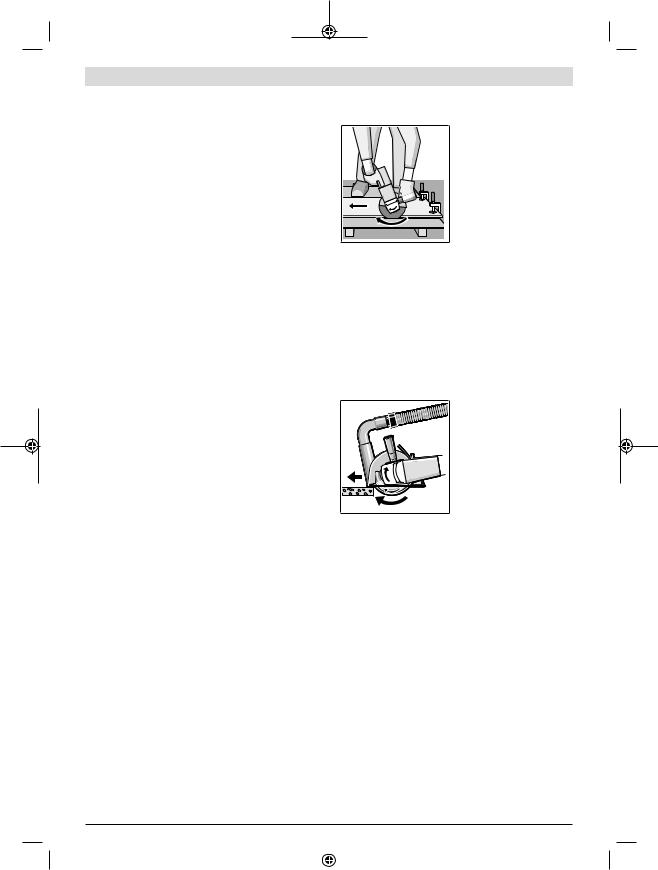
12 | English
Switching on/off
To start the power tool, push the on/off switch (2) forward and then press it down.
To lock the on/off switch (2) in position, push the on/off switch (2) further forward.
To switch off the power tool, release the on/off switch (2); or, if the switch is locked, briefly press the on/off switch (2) and then release it.
Switch without locking mechanism (country-specific):
To start the power tool, push the on/off switch (2) forward
and then press it down.
To switch off the power tool, release the on/off switch (2).
uAlways check abrasive tools before using them. The abrasive tool must be fitted properly and be able to move freely. Carry out a test run for at least one minute with no load. Do not use abrasive tools that are damaged, run untrue or vibrate during use. Damaged abrasive tools can burst apart and cause injuries.
Working Advice
uPull the plug out of the socket before carrying out any work on the power tool.
uExercise caution when cutting slots in structural walls; see the "Information on structures" section.
uClamp the workpiece if it is not secure under its own weight.
uDo not load the power tool so heavily that it comes to a stop.
uIf the power tool has been subjected to a heavy load, continue to run it at no-load for several minutes to cool down the accessory.
uDo not touch grinding and cutting discs until they have cooled down. The discs can become very hot while working.
uDo not use the power tool with a cut-off stand.
Rough grinding
u Never use cutting discs for rough grinding.
The best rough grinding results are achieved with a set angle of 30° to 40°. Move the power tool back and forth with moderate pressure. This will ensure that the workpiece does not become too hot or discolour and that grooves are not formed.
Flap Disc
With the flap disc (accessory), curved surfaces and profiles can be worked. Flap discs have a considerably higher service life, lower noise levels and lower sanding temperatures than conventional sanding sheets.
Cutting Metal
uAlways use the protective guard for cutting (13) when cutting bonded abrasives.
When carrying out abrasive cutting, use a moderate feed that is suited to the material being machined. Do not exert pressure on the cutting disc and do not tilt or swing the power tool.
Do not attempt to reduce the speed of a cutting disc coming to a stop by applying pressure from the side.
The power tool must always work in an up-grinding motion. Otherwise, there is a risk that it will be pushed
uncontrolled out of the cut.
For best results when cut-
ting profiles and rectangular
tubing, start at the smallest
cross section.
Cutting stone
uProvide sufficient dust extraction when cutting stone.
uWear a dust mask.
uThe power tool may be used only for dry cutting/grinding.
For best results when cutting stone, use a diamond cutting disc.
Operate the power tool only with dust extraction and also wear a dust respirator.
The vacuum cleaner must be approved for the extraction of stone dust. Suitable vacuum cleaners are available from Bosch.
Switch on the power tool and position it with the
front part of the cutting
guide on the workpiece. Move the power tool with a
moderate feed motion that
is suited to the material be-
ing machined.
When cutting especially hard materials such as con-
crete with a high pebble content, the diamond cutting disc can overheat and become damaged as a result. This is clearly indicated by circular sparking, rotating with the diamond cutting disc.
If this happens, stop cutting and allow the diamond cutting disc to cool down by running the power tool for a short time at maximum speed with no load.
If work is noticeably slower and with circular sparking, this indicates that the diamond cutting disc has become dull. You can resharpen the disc by briefly cutting into abrasive material (e.g. lime-sand brick).
Information on structural design
Slots in load-bearing walls are subject to DIN 1053 part 1 or country-specific regulations. These regulations must be observed under all circumstances. Seek advice from the responsible structural engineer, architect or construction supervisor before starting work.
1 609 92A 438 | (26.11.2018) |
|
|
|
Bosch Power Tools |
|
|
|
|
|
|
|
|
|
|
|
|
|
|
|
|
|
|
|
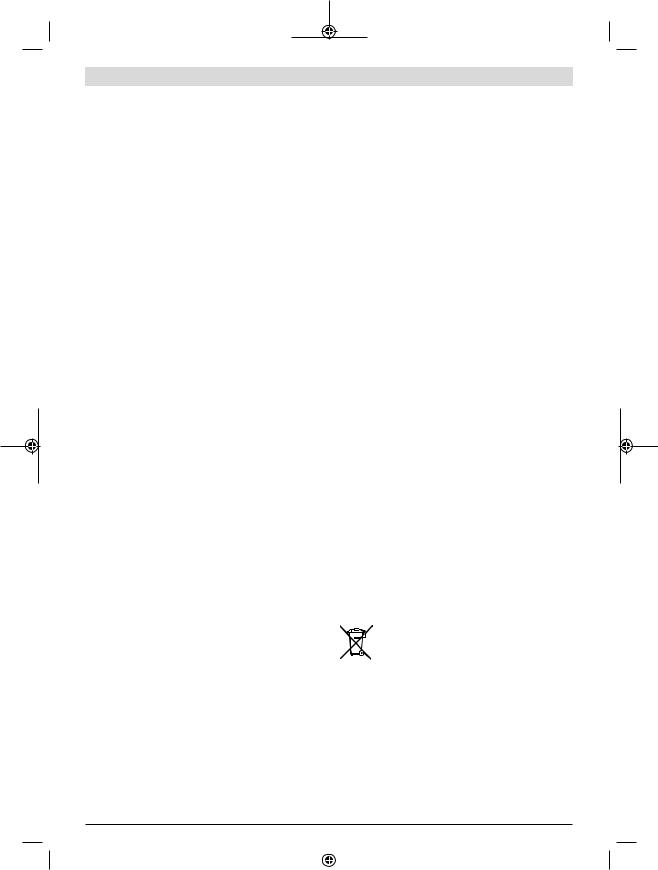
Maintenance and Servicing
Maintenance and Cleaning
uPull the plug out of the socket before carrying out any work on the power tool.
uTo ensure safe and efficient operation, always keep the power tool and the ventilation slots clean.
uIn extreme conditions, always use a dust extractor if possible. Blow out ventilation slots frequently and install a residual current device (RCD) upstream. When machining metals, conductive dust can settle inside the power tool, which can affect its protective insulation.
Store and handle the accessories carefully.
In order to avoid safety hazards, if the power supply cord needs to be replaced, this must be done by Bosch or by an after-sales service centre that is authorised to repair Bosch power tools.
After-sales service and advice on using products
Our after-sales service responds to your questions concerning maintenance and repair of your product as well as spare parts. You can find explosion drawings and information on spare parts at: www.bosch-pt.com
The Bosch product use advice team will be happy to help you with any questions about our products and their accessories.
In all correspondence and spare parts orders, please always include the 10 digit article number given on the nameplate of the product.
Great Britain
Robert Bosch Ltd. (B.S.C.)
P.O. Box 98
Broadwater Park
North Orbital Road
Denham Uxbridge
UB 9 5HJ
At www.bosch-pt.co.uk you can order spare parts or arrange the collection of a product in need of servicing or repair.
Tel. Service: (0344) 7360109
E-Mail: boschservicecentre@bosch.com
Ireland
Origo Ltd.
Unit 23 Magna Drive
Magna Business Park
City West
Dublin 24
Tel. Service: (01) 4666700
Fax: (01) 4666888
Australia, New Zealand and Pacific Islands
Robert Bosch Australia Pty. Ltd.
Power Tools
Locked Bag 66
Clayton South VIC 3169
Customer Contact Center
Inside Australia:
English | 13
Phone: (01300) 307044
Fax: (01300) 307045
Inside New Zealand:
Phone: (0800) 543353
Fax: (0800) 428570
Outside AU and NZ:
Phone: +61 3 95415555
www.bosch-pt.com.au
www.bosch-pt.co.nz
Republic of South Africa
Customer service
Hotline: (011) 6519600
Gauteng – BSC Service Centre
35 Roper Street, New Centre
Johannesburg
Tel.: (011) 4939375
Fax: (011) 4930126
E-mail: bsctools@icon.co.za
KZN – BSC Service Centre
Unit E, Almar Centre
143 Crompton Street
Pinetown
Tel.: (031) 7012120
Fax: (031) 7012446
E-mail: bsc.dur@za.bosch.com
Western Cape – BSC Service Centre
Democracy Way, Prosperity Park
Milnerton
Tel.: (021) 5512577
Fax: (021) 5513223
E-mail: bsc@zsd.co.za
Bosch Headquarters
Midrand, Gauteng
Tel.: (011) 6519600
Fax: (011) 6519880
E-mail: rbsa-hq.pts@za.bosch.com
Disposal
The power tool, accessories and packaging should be recycled in an environmentally friendly manner.
Do not dispose of power tools along with household waste.
Bosch Power Tools |
|
|
|
1 609 92A 438 | (26.11.2018) |
|
|
|
|
|
|
|
|
|
|
|
|
|
|
|
|
|
|
|
